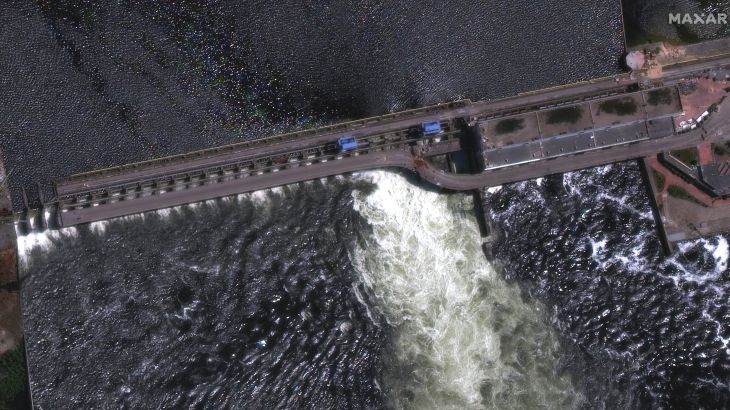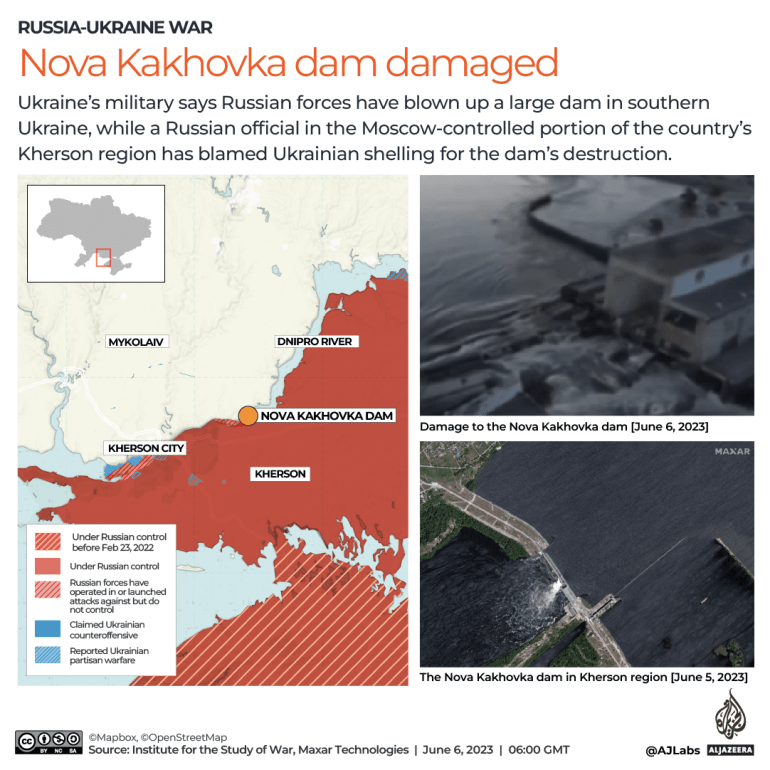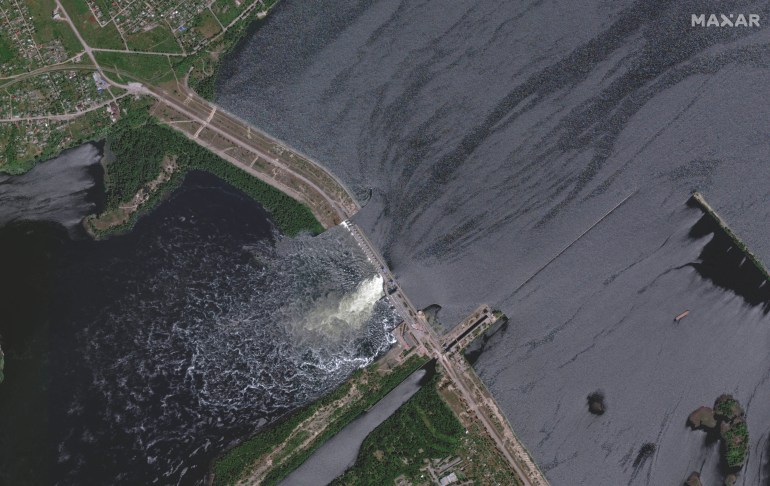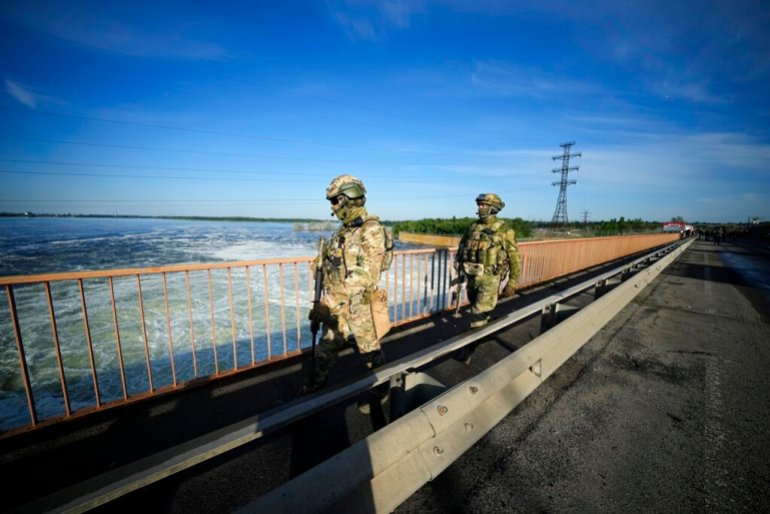Ukraine, Russia trade blame for destruction of Nova Kakhovka dam
Authorities are evacuating residents in several areas following the destruction of large Soviet-era dam.

Kyiv has accused Russian forces of blowing up a large dam in southern Ukraine, while the Moscow-installed official in the city of Nova Kakhovka in the Russian-controlled portion of the Kherson region blamed the structure’s destruction on Ukrainian shelling.
Ukrainian President Volodymyr Zelenskyy accused “Russian terrorists” of destroying the dam early on Tuesday and said the outrage “confirms for the whole world that they must be expelled from every corner of Ukrainian land”.
Keep reading
list of 4 itemsAll to know about Ukraine’s Nova Kakhovka dam explosion
Zelenskyy lauds Ukraine advance amid counteroffensive speculation
Russia to face Ukraine at UN court over downing of flight MH17
“Not a single meter should be left to them, because they use every meter for terror,” said Zelenskyy, who called an emergency meeting of the country’s national security council. “The terrorists will not be able to stop Ukraine with water, missiles or anything else,” he wrote on Twitter.

But the Kremlin accused Kyiv of sabotaging the dam to distract attention from a purportedly faltering counteroffensive against Russian forces.
“We can state unequivocally that we are talking about deliberate sabotage by the Ukrainian side,” Kremlin spokesman Dmitry Peskov told reporters.
He added that Ukraine was also aiming to deprive Russian-annexed Crimea of the freshwater it receives from the reservoir via the North Crimean Canal.
Commenting on allegations that Russia was responsible for the blast, Peskov said: “We can strongly reject this. We officially declare that here we are definitely talking about deliberate sabotage from the Ukrainian side.”
Soviet-era dam
The dam, 30 metres (some 98 feet) tall and 3.2km (2 miles) long, was built in 1956 on the Dnipro River as part of the Kakhovka Hydroelectric Power Plant.
The southern command of Ukrainian armed forces said the “scale of the destruction” was being assessed as Ukraine’s military administration for the Kherson region called on people to be ready to evacuate from villages on the right bank of the Dnipro River before expected flooding.
“The water level is rising and everyone who is in the danger zone must: Turn off all electrical appliances; take documents and essentials; take care of loved ones and pets; follow the instructions of rescuers and policemen,” the Kherson administration said on its Telegram channel.
“About 16,000 people are in the critical zone on the right bank of the Kherson region,” said Oleksandr Prokudin, head of the Kherson military administration, adding that there was already flooding in eight areas along the Dnipro River.

Mykhailo Podolyak, adviser to the Ukrainian presidential office, accused Russia of destroying the dam in “a panic” in order to slow down the Ukrainian counteroffensive, saying the consequences of Russia’s actions were “already catastrophic”.
“On a vast territory, all life will be destroyed; many settlements will be ruined; colossal damage will be done to the environment,” he said.
The office of the prosecutor general said Ukraine was investigating the incident as a possible war crime and as possible criminal environmental destruction, or “ecocide”.
But RIA Novosti news agency quoted the Moscow-installed mayor of Nova Kakhovka, Vladimir Leontiev, as saying the dam had been hit by shelling which he blamed on Ukraine.
“There were several hits” on the dam, he said, according to the Russian news agency. “This crime cannot be written off. This is a terrorist act directed against civilians, Ukrainians did it,” he said.
Torrent of water
Al Jazeera’s Charles Stratford, reporting from Kyiv, said analysts had long seen the dam as a potential target for both sides in the war.
The dam is vital for water supply and irrigation in Russian-occupied Crimea, while Russia could see its destruction as a way of making it more difficult for Ukrainian forces to cross the Dnipro River and enter Crimea in a ground offensive, Stratford said, adding that the evacuation of settlements in the area had already begun.
“We are also hearing from the Ukrainians that they believe … water levels will reach a critical point around five hours from now. We also know there are ongoing evacuations from some of the settlements that are going to be affected,” he said.

The Soviet-era dam in the Russian-controlled part of the Kherson region could unleash a flood across the war zone, according to Ukrainian and Russian forces.
Unverified videos on social media showed a series of intense explosions around the dam.
Other videos showed water surging through its remains with bystanders expressing their shock, sometimes in strong language.
Ukraine controls five of the six dams along the Dnipro, which runs from the country’s northern border with Belarus down to the Black Sea and is crucial for the entire country’s drinking water and power supply.
The Nova Kakhovka dam – the one furthest downstream – is controlled by Russian forces and contains an 18-cubic-kilometre (4.3-cubic-mile) reservoir which supplies water to the Crimean Peninsula, which was annexed by Russia in 2014, and to the Zaporizhzhia Nuclear Power Plant, which is also under Russian control.
Ukraine’s nuclear operator Energoatom said in a Telegram statement that the blowing up of the dam “could have negative consequences for the Zaporizhzhia Nuclear Power Plant”, but the situation is “controllable” at the moment.
The United Nations International Atomic Energy Agency wrote on Twitter that its experts were closely monitoring the situation at the Zaporizhzhia Nuclear Power Plant upstream, and there was “no immediate nuclear safety risk” at the facility.
The IAEA is aware of reports of damage at #Ukraine’s Kakhovka dam; IAEA experts at #Zaporizhzhya Nuclear Power Plant are closely monitoring the situation; no immediate nuclear safety risk at plant.#ZNPP
— IAEA – International Atomic Energy Agency ⚛️ (@iaeaorg) June 6, 2023
Europe’s largest nuclear facility uses water from the dam to cool six reactors as well as spent fuel and emergency diesel generators.
IAEA chief Rafael Grossi said in a statement that alternative sources of water near the facility should be sufficient to guarantee its safety. “A main one is the large cooling pond next to the site that by design is kept above the height of the reservoir,” he said.
“It is therefore vital that this cooling pond remains intact. Nothing must be done to potentially undermine its integrity. I call on all sides to ensure nothing is done to undermine that.”
According to the Ukraine War Environmental Consequences Working Group, a total collapse in the dam would wash away much of the left bank and a severe drop in the reservoir has the potential to deprive the nuclear plant of crucial cooling, as well as dry up the water supply in northern Crimea.
NATO Secretary-General Jens Stoltenberg called the attack “outrageous” and said it highlighted the devastation wrought by Moscow’s invasion.
“The destruction of the Kakhovka dam today puts thousands of civilians at risk and causes severe environmental damage. This is an outrageous act, which demonstrates once again the brutality of Russia’s war in Ukraine,” Stoltenberg wrote on Twitter.
European Union chief Charles Michel pledged to hold Russia accountable for the “war crime” of destroying civilian infrastructure.
“Shocked by the unprecedented attack of the Nova Kakhovka dam. The destruction of civilian infrastructure clearly qualifies as a war crime – and we will hold Russia and its proxies accountable,” Michel wrote on social media.
Lithuania’s president and the foreign ministers of Latvia and Estonia also said the incident amounted to a war crime for which Russia must be held accountable.
“Today we witness an unprecedented Russian attack against Ukrainian civilian infrastructure,” Lithuanian President Gitanas Nauseda tweeted.
“The destruction of a major dam is a crime of war that directly threatens thousands of people. Russia must be held accountable for it,” he said. “And Ukraine must win this war to stay safe!”